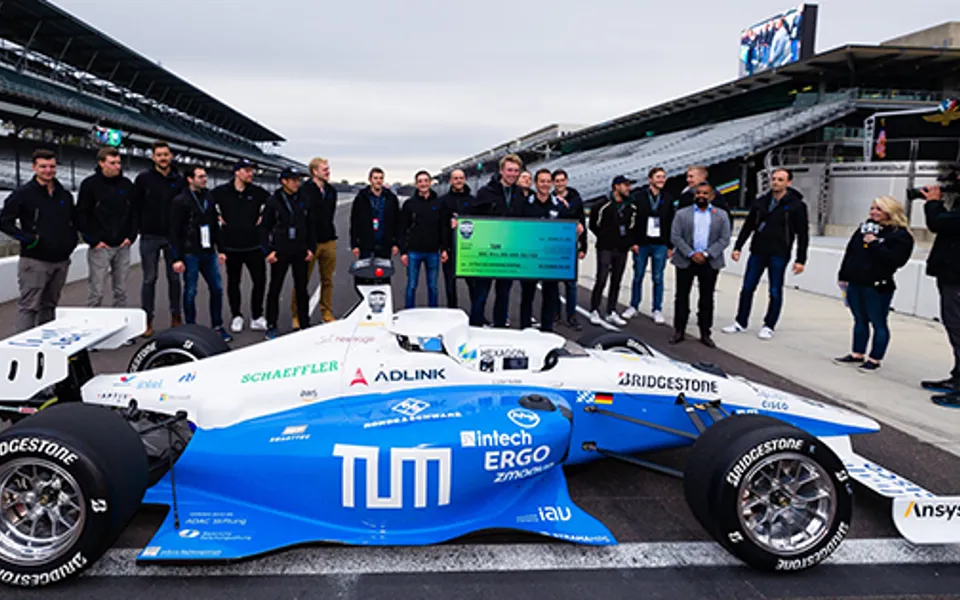
Ricardo congratulates inaugural winners of the Indy Autonomous Challenge
25 Oct 2021
TUM Autonomous Motorsport from the Technische Universität München (TUM) has won the first ever Indy Autonomous Challenge: the world’s first head-to-head, high-speed autonomous race at the Indianapolis Motor Speedway in the US on Saturday 23 October. The team at Ricardo Performance Products had particular interest in the race. Building on the long-standing relationship that Ricardo shares with Dallara our bespoke transmissions featured in all of the Dallara AV-21 race cars which competed.
Drawing on Ricardo’s multiple world-championship winning expertise in motorsport, the transmissions were designed and manufactured by specialist engineers and the niche manufacturing team at Ricardo’s Midlands Technical Centre in Leamington Spa. Steve Blevins, Head of Engineering for Ricardo Performance Products, led the programme and here, he gives his insight into the particular engineering requirements and challenges of this unique race series.
Q1: What are the key features of the Ricardo transmission used in the Indy Autonomous Challenge?
Steve Blevins: “This Ricardo transmission has been tried and tested in a number of race series including: the World Series by Renault and, currently, Indy Lights Presented by Cooper Tires, Super Formula in Japan, the Rodin FZED single-seat track car and the Japanese Inter Pro Series”
“The Dallara chassis for the Indy Autonomous Challenge is based on the IL15 chassis used in Indy Lights. Ricardo has been supplying the race since 2002 and is proud to continue the supply of this type of gearbox to this exciting programme.”
“While the base gearbox is the same, the modular nature of the assembly allows differing final drives, ratio sets, shift mechanisms, reverse gear train and differential specifications to be configured to suit this new application.”
“The gearbox used in the Indy Autonomous Challenge has a unique configuration of many race-proven components, but the only unique part of the gearbox assembly is the clutch shaft to suit the new engine.”
“Basing the Indy Autonomous Challenge gearbox on this range of existing parts gives confidence that it will perform faultlessly in an application that is pushing boundaries in other areas.”
Q2: What are the unique challenges presented by the Indy Autonomous Challenge?
Steve Blevins: “From the gearbox side, we’ve needed to configure it mechanically, so it works with the amended control systems on the car. Removing the driver has had a big effect on all aspects of the car, including the gearbox which has required three-fold changes; related to clutch control, gear ratios, and gearshift.”
“There’s no clutch control interface on the gearbox itself. However, we were asked to configure the overall first gear ratio as low as possible to help protect the clutch on launch. The car uses a centrifugal clutch with the locking proportional to rotation speed: as the engine revs pick up, the clutch begins to lock, and the car starts to move forward. During this process the clutch is slipping, so first gear ratio is as low as we’re able to go to minimise this slip effect.”
“The car is geared in sixth gear to the same maximum speed as the ‘normal’ IL15 chassis so the top speed of the Indy Autonomous Challenge car could be the same. The Indy Autonomous Challenge gearbox has a different ratio set, equally spaced between first and sixth to allow progressive increases in speeds in each gear. This allows the car to run at lower speeds in initial testing, getting faster as confidence grows. The ‘Indy Lights’ chassis (on a Speedway oval) runs a ratio set with fifth and sixth gear ratios close together to help overtakes following drafting. Drafting may be something the Indy Autonomous Challenge cars can learn, but it is not been allowed for in the ratio set presently.”
Q3: How is our engineering and manufacturing approach for this event different from other race series which Ricardo supports?
Steve Blevins: “We’ve considered the project in the same way as all of our motorsport programmes. However, as this is effectively a ‘spec series’ – all the cars are (physically) the same – then ultimate performance isn’t as important as driveability and reliability. Our focus has therefore been slightly different than if it were a series in which different chassis (and gearboxes) competed. For us the benefit of a spec series is that irrespective of which team crosses the line first, then we know our gearbox will be in the winning car!”










